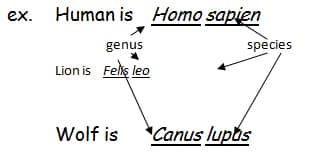With the large diversity (variety) we need to sort or take inventory of everything (classify and name) classifying involves arranging living and nonliving things into groups which we can then study separately we also must give everything a name so that we can exchange information with others around the world.
Naming
Scientists have developed a special system for naming organisms so that each organism has a different name which is understood by all scientists.
created by Carl Linnaeus, a Swedish biologist, in the 18th century
Latin was the chosen language for the system (Latin was chosen because in the 1700’s this was the language of the scholars)
Binomial nomenclature
each organism has a 2-part name
the 1st part of the name is called the genus which indicates that it is a group of species that haveclosely related structures
the 2nd part of the name is called the species which is a group of mating organisms that do not mate with other groups.
Rules for naming using binomial nomenclature
1) Genus is capitalized
2) Species is lowercase
3) Each name is underlined; usually italicised when in a scientific document

